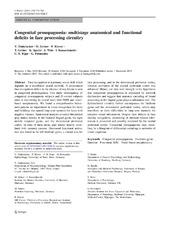Congenital prosopagnosia: multistage anatomical and functional deficits in face processing circuitry
Dinkelacker, V.; Grüter, M.; Klaver, P.; Grüter, T.; Specht, Karsten; Weis, S.; Kennerknecht, I.; Elger, C. E.; Fernandez, G.
Peer reviewed, Journal article
Published version
Permanent lenke
https://hdl.handle.net/1956/5254Utgivelsesdato
2011Metadata
Vis full innførselSamlinger
Sammendrag
Face recognition is a primary social skill which depends on a distributed neural network. A pronounced face recognition deficit in the absence of any lesion is seen in congenital prosopagnosia. This study investigating 24 congenital prosopagnosic subjects and 25 control subjects aims at elucidating its neural basis with fMRI and voxelbased morphometry. We found a comprehensive behavioral pattern, an impairment in visual recognition for faces and buildings that spared long-term memory for faces with negative valence. Anatomical analysis revealed diminished gray matter density in the bilateral lingual gyrus, the right middle temporal gyrus, and the dorsolateral prefrontal cortex. In most of these areas, gray matter density correlated with memory success. Decreased functional activation was found in the left fusiform gyrus, a crucial area for face processing, and in the dorsolateral prefrontal cortex, whereas activation of the medial prefrontal cortex was enhanced. Hence, our data lend strength to the hypothesis that congenital prosopagnosia is explained by network dysfunction and suggest that anatomic curtailing of visual processing in the lingual gyrus plays a substantial role. The dysfunctional circuitry further encompasses the fusiform gyrus and the dorsolateral prefrontal cortex, which may contribute to their difficulties in long-term memory for complex visual information. Despite their deficits in face identity recognition, processing of emotion related information is preserved and possibly mediated by the medial prefrontal cortex. Congenital prosopagnosia may, therefore, be a blueprint of differential curtailing in networks of visual cognition.

